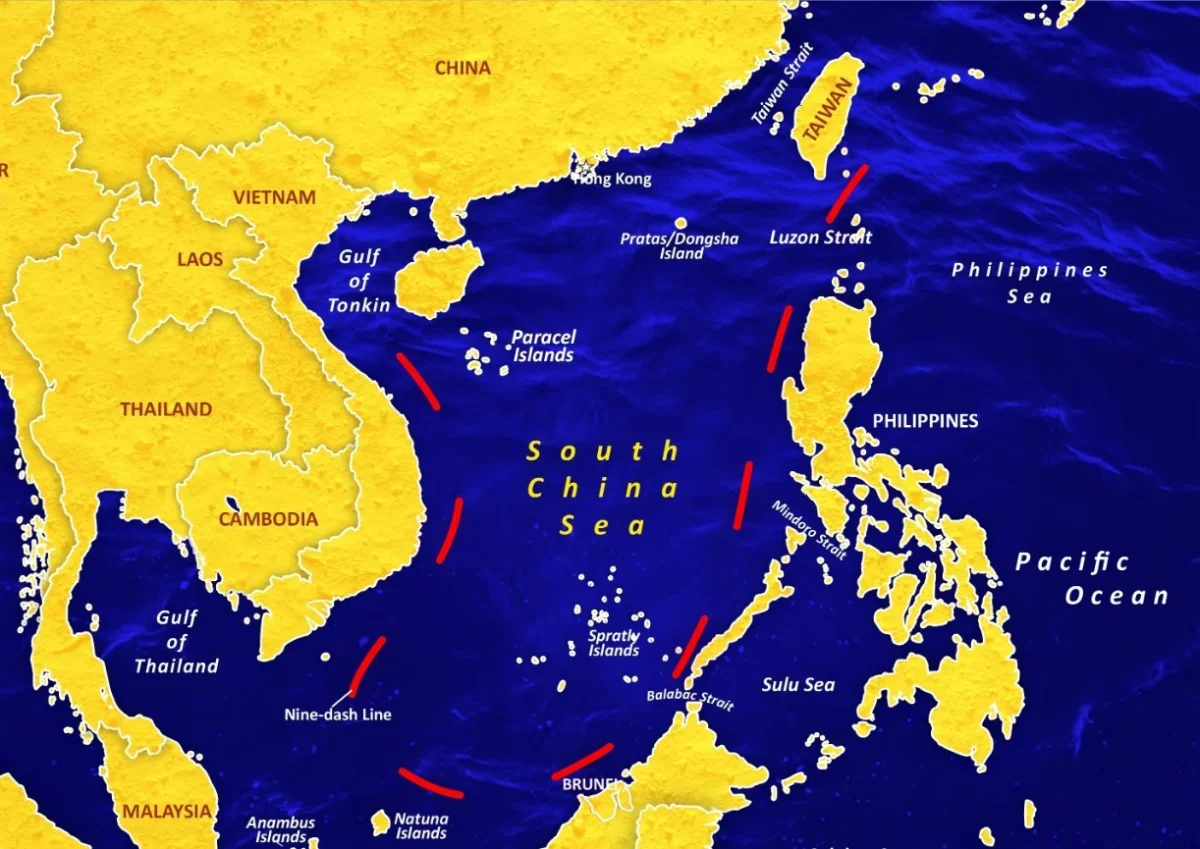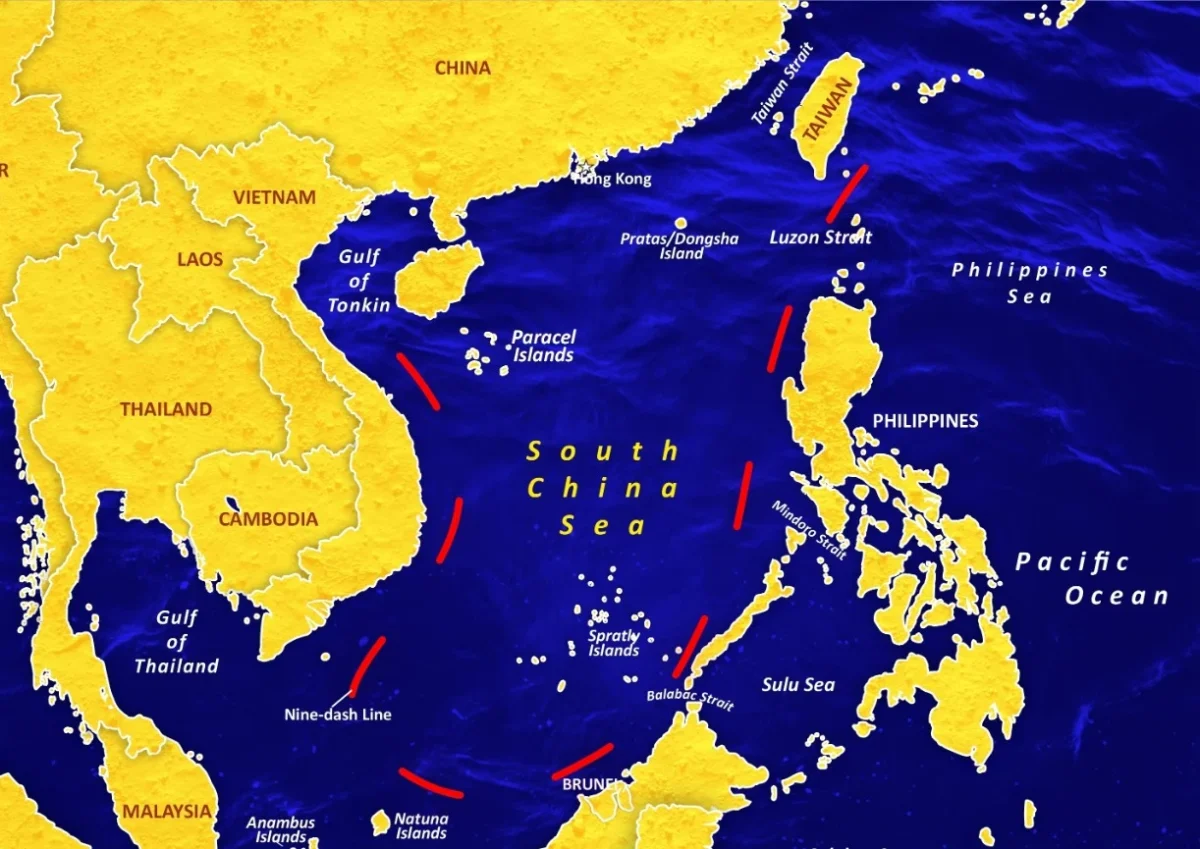HOW THE DIPLOMATIC CHANNELS ARE MORE IMPORTANT TO SOLVE SOUTH CHINA SEA DISPUTE RATHER THAN LEGAL JUDGEMENTS?
Table of Contents
INTRODUCTION
The South China Sea dispute involves claims to islands as well as maritime areas, such as reefs, banks, and other sea features. It also involves the Spratly Islands, Paracel Islands, Scarborough Shoal, and multiple Gulf of Tonkin boundaries. The disputed sovereign states are Brunei, Taiwan, Malaysia, Philippines, Vietnam, Indonesia, and People’s Republic of China. The People’s Republic of China claims most of the area enclosed by the nine-dash line; these claims subsequently overlap with claims to the exclusive economic zones of Brunei, Indonesia, Malaysia, the Philippines, Taiwan, and Vietnam. The legacy of the nine-dash line is viewed by PRC government officials, and by the PRC military, as providing historical support for their claims to the South China Sea which was adopted in 1949. In 2013, the PRC began island building in the Spratly Islands and Paracel Islands region. This process primarily by Vietnam and the Philippines has been going on for decades but China constructed more new island surfaces than all other nations have constructed throughout the history between 2014 and 2016 only and also placed military equipment on one of its artificial islands unlike the other claimants. Non claimants want the region to remain as international waters, with the USA conducting “freedom of navigation” operations.

CRITICAL IMPORTANCE OF SOUTH CHINA SEA
One of the world’s most significant areas for the environment and economy is the South China Sea. This stretch of waterway is the second most used in the world, carrying about 30% of all global trade. More than half of the world’s merchant fleet travels through the Straits of Malacca and Sunda each year. Because of its abundance of marine life, it serves as a major fishing industry source. It has proven oil reserves of about 7.7 billion barrels, with an estimated total of 28 billion barrels, making it one of its natural strategic resources. It is estimated that there are 266 trillion cubic feet of natural gas reserves. Additionally, it serves as a strategic route that links the Pacific and Indian oceans. The security of this region and the entire world will be jeopardised by any conflict that arises in this economically, strategically, or geopolitically significant area. India and many other countries around the world are interested in protecting the water lanes because of how important this area is.
2016 PCA JUDGEMENT
In 2013, Philippines brought the issues to the Permanent Court of Arbitration against China’s claims on territories which it said were unlawful under the UNCLOS. Despite China’s withdrawal from the arbitration, the proceedings proceeded according to schedule because, according to UNCLOS guidelines, a party’s incapacity or absence from the arbitration shall not prevent the proceedings from proceeding. In 2016, the court ruled against China stating that China had no claim to an area that was determined by the tribunal to be a part of Philippines EEZ. It stated that any prior claims to resources situated in the nine-dash line was unfounded. It also said that China has violated the sovereign rights of the Philippines by interfering in its Exclusive Economic Zone (EEZ) by constructing artificial islands and by failing to stop Chinese fishermen from fishing in this area. Also, China has no legal basis for asserting its historical claims in the area of South China Sea. But China, despite being a signatory to the treaty that established the tribunal, refused to accept the ruling of the court. It rejected the ruling calling it ill-defined. The Chinese have instead sought to undertake confidence building measures and work out a legally binding Code of Conduct (COC).
RECENT DEVELOPMENTS IN THE AREA
Recently China has released the 10-dash line map which claims a large part of territories of India, Malaysia, Taiwan, and South China Sea as its own. India is clear on its stand that the mere publication of any such map cannot change the truths and the ground realities. Malaysia also rejected the map. Although such steps can be found as provocative the Chinese Foreign Ministry spokesman Wang Wenbin said that release of the map was a routine exercise of sovereignty in accordance with the law. The Philippines also rejected such a move by the Chinese authority and said that it will continue to exercise its sovereignty in its EEZ and freedom of navigation in the exclusive area. India, in June, while emphasising the call for an open, free and inclusive Indo-Pacific also joined Philippines in openly calling China to abide by the 2016 judgement of PCA. This is a departure from the earlier statements of India. From “noted” to “adherence” is a recognition of the legitimacy of the judgement. Meanwhile, the Philippines has allowed an extension to US troops present in its local camps under the 2014 pact. China warned the Philippines that the activities should not infringe upon its territorial rights in the South China Sea.

The USA also has high stakes in the area. From time to time, it conducts “freedom of navigation” operations due to which China also at times gets aggressive in the region. Recently, the USA has attempted to bring together Japan and South Korea, who have historical differences, by making them part of a security agreement. This trilateral security agreement, The Camp David agreement, may result in a more aggressive attitude of China as it is crystal clear that the prime objective of this agreement is to contain China in the region. The participants have themselves said that China’s attitude, specifically in the South China Sea region, is aggressive and dangerous. China has already expressed its displeasure with the summit. It has seen the summit as a gross interference in its internal affairs. It also expressed discontent with freedom of navigation operations by the USA, saying that America conducts such operations together with its allies in the region often to express its military capabilities. Though the USA does not have any territorial claims over the contested region, it has asserted that freedom of navigation and flight as well as resolving the disputes peacefully are in its national interests.
WAY FORWARD & CONCLUSION
The PCA has made its judgement in 2016 criticising China and giving Philippines the right over its Exclusive Economic Zone, the refusal by China to abide by the judgement has hardly changed the ground realities of the region. It is practically impossible to carry out the decision. By emphasising the need for the resolution of the conflict by peaceful means that respects the legal and diplomatic channels and also respects the judgement of PCA, India has stressed on the need that the region wants peace and the mutual respect for the international laws. There is acceptance in the diplomatic channels that solving the issue by legal means is very difficult. Therefore, the dialogues should be stressed upon. Also, ASEAN member countries have internal differences regarding the South China Sea. It is necessary that all the differences should be sidelined and ASEAN countries must be on the same page when it comes to forming diplomatic pressure on China. This is the right time as there is a very high chance that they will get support from the USA and India too. The creation of a political framework and the responsibility of a binding “code of conduct” falls heavier on ASEAN member countries.



